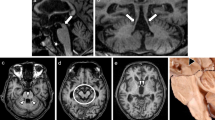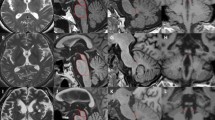Abstract
Background
To enhance the sensitivity and specificity of the clinical diagnosis of progressive supranuclear palsy (PSP), neuroradiological parameters established in pathologically proven cases are needed.
Methods
We examined brainstem atrophy in five pathologically confirmed PSP patients (three men, mean age at death 77 years, range 64–84 years). Time interval between symptom onset and MRI ranged from 1 to 5 years, and between MRI and death from 33 to 52 months. Only one patient had clinical diagnosis of PSP at the time of MRI. Control group consisted of 19 age- and gendermatched healthy subjects. Seventeen morphometric parameters of the midbrain and pons were measured on T1-weighted midsagittal and T2-weighted axial MRI scans with Image Analyzer. Measurements of superior cerebellar peduncle (SCP) width were performed on PSP autopsy specimens.
Results
Mean SCP width on MRI in PSP (2.7 ± 0.8 mm, 95%CI: 2.1–3.3) was smaller than in controls (3.7 ± 0.5 mm, 95%CI: 3.5–3.9). Mean SCP width at autopsy was 8% smaller than mean SCP width on MRI. Midsagittal midbrain area in PSP (99.1 ± 6.9 mm2, 95%CI: 90.5–107.6) was smaller than in controls (141.0 ± 18.1 mm2, 95%CI: 132.2–149.7). Midbrain/pons area ratio in PSP was 1:5 and in controls was 1:4 (p < 0.01). Repeat MRI 17 months later in one PSP case revealed 30% decrease of SCP width.
Conclusions
MR imaging with quantitative analysis may be useful in the diagnosis of early PSP and in monitoring disease course.
Similar content being viewed by others
References
Adachi M,Kawanami T, Ohshima H, Sugai Y,Hosoya T (2004) Morning glory sign: a particular MR finding in progressive supranuclear palsy. Magn Reson Med Sci 3:125–132
Aiba I, Hashizume Y, Yoshida M, Okuda S, Murakami N, Ujihira N (1997) Relationship between brainstem MRI and pathological findings in progressive supranuclear palsy – study in autopsy cases. J Neurol Sci 152:210–217
Boxer AL, Geschwind MD, Belfor N, Gorno-Tempini ML, Schauer GF, Miller BL, Weiner MW, Rosen HJ (2006) Patterns of brain atrophy that differentiate corticobasal degeneration syndrome from progressive supranuclear palsy. Arch Neurol 63:81–86
Cordato NJ,Duggins AJ,Halliday GM, Morris JG, Pantelis C (2005) Clinical deficits correlate with regional cerebral atrophy in progressive supranuclear palsy. Brain 128:1259–1266
Groschel K, Hauser TK, Luft A, Patronas N, Dichgans J, Litvan I, Schulz JB (2004) Magnetic resonance imaging- based volumetry differentiates progressive supranuclear palsy from corticobasal degeneration. Neuroimage 21:714–724
Hauw JJ, Agid Y (2003) Progressive supranuclear palsy (PSP) or Steele- Richardson-Olszewski disease. In: Dickson D (ed) Neurodegeneration: the molecular pathology of dementia and movement disorders. ISN Neuropath Press, Basel, pp 103–114
Hauw JJ, Daniel SE, Dickson D, Horoupian DS, Jellinger K, Lantos PL, McKee A, Tabaton M, Litvan I (1994) Preliminary NINDS neuropathologic criteria for Steele-Richardson-Olszewski syndrome (progressive supranuclear palsy). Neurology 44:2015–2019
Hughes AJ, Daniel SE, Ben-Shlomo Y, Lees AJ (2002) The accuracy of diagnosis of parkinsonian syndromes in a specialist movement disorder service. Brain 125:861–870
Hughes AJ, Daniel SE,Kilford L, Lees AJ (1992) Accuracy of clinical diagnosis of idiopathic Parkinson's disease: a clinico-pathological study of 100 cases. J Neurol Neurosurg Psychiatry 55:181–184
Josephs KA, Whitwell JL, Boeve BF, Shiung MM, Gunter JL, Parisi JE, Dickson DW, Jack CR (2006) Rates of cerebral atrophy in autopsy-confirmed progressive supranuclear palsy. Ann Neurol 59:200–203
Kato N, Arai K, Hattori T (2003) Study of the rostral midbrain atrophy in progressive supranuclear palsy. Neurol Sci 210:57–60
Litvan I, Agid Y, Calne D, Campbell G, Dubois B, Duvoisin RC, Goetz CG, Golbe LI, Grafman J, Growdon JH, Hallett M, Jankovic J, Quinn NP, Tolosa E, Zee DS (1996) Clinical research criteria for the diagnosis of progressive supranuclear palsy (Steele-Richardson- Olszewski syndrome): report of the NINDS-SPSP international workshop. Neurology 47:1–9
Litvan I, Agid Y, Jankovic J, Goetz C, Brandel JP, Lai EC, Wenning G, D'Olhaberriague L, Verny M, Chaudhuri KR, McKee A, Jellinger K, Bartko JJ, Mangone CA, Pearce RK (1996) Accuracy of clinical criteria for the diagnosis of progressive supranuclear palsy (Steele-Richardson-Olszewski syndrome). Neurology 46:922–930
Litvan I, Bhatia KP, Burn DJ, Goetz CG, Lang AE, McKeith I, Quinn N, Sethi KD, Shults C, Wenning GK (2003) Movement Disorders Society Scientific Issues Committee Report: SIC Task Force appraisal of clinical diagnostic criteria for Parkinsonian disorders. Mov Disord 18:467–486
Oba H, Yagishita A, Terada H, Barkovich AJ, Kutomi K, Yamauchi T, Furui S, Shimizu T, Uchigata M, Matsumura K, Sonoo M, Sakai M, Takada K, Harasawa A, Takeshita K, Kohtake H, Tanaka H, Suzuki S (2005) New and reliable MRI diagnosis for progressive supranuclear palsy. Neurology 64:2050–2055
Oka M, Katayama S, Imon Y, Ohshita T, Mimori Y, Nakamura S (2001) Abnormal signals on proton densityweighted MRI of the superior cerebellar peduncle in progressive supranuclear palsy. Acta Neurol Scand 104:1–5
Paviour DC, Price SL, Jahanshahi M, Lees AJ, Fox NC (2006) Longitudinal MRI in progressive supranuclear palsy and multiple system atrophy: rates and regions of atrophy. Brain 129:1040–1049
Paviour DC, Price SL, Stevens JM, Lees AJ, Fox NC (2005) Quantitative MRI measurement of superior cerebellar peduncle in progressive supranuclear palsy. Neurology 64:675–679
Rajput AH, Rozdilsky B, Rajput A (1991) Accuracy of clinical diagnosis in parkinsonism – a prospective study. Can J Neurol Sci 18:275–278
Righini A, Antonini A, De Notaris R, Bianchini E, Meucci N, Sacilotto G, Canesi M, De Gaspari D, Triulzi F, Pezzoli G (2004) MR imaging of the superior profile of the midbrain: differential diagnosis between progressive supranuclear palsy and Parkinson disease. AJNR 25:927–932
Savoiardo M, Strada L, Girotti F, D'Incerti L, Sberna M, Soliveri P, Balzarini L (1989) MR imaging in progressive supranuclear palsy and Shy-Drager syndrome. J Comput Assist Tomogr 13:555–560
Schrag A, Good CD, Miszkiel K, Morris HR, Mathias CJ, Lees AJ, Quinn NP (2000) Differentiation of atypical parkinsonian syndromes with routine MRI. Neurology 54:697–702
Steele JC, Richardson JC, Olszewski J (1964) Progressive supranuclear palsy. Arch Neurol 10:333–359
Tsuboi Y, Slowinski J, Josephs KA, Honer WG, Wszolek ZK, Dickson DW (2003) Atrophy of superior cerebellar peduncle in progressive supranuclear palsy. Neurology 60:1766–1769
Victor M, Ropper AH (2001) Disorders of ocular movement and pupillary function. In: Victor M, Ropper AH (eds) Adams and Victor's principles of neurology. McGraw-Hill,New York, pp 271–300
Warmuth-Metz M, Naumann M, Csoti I, Solymosi L (2001) Measurement of the midbrain diameter on routine magnetic resonance imaging. Arch Neurol 58:1076–1079
Williams DR, de Silva R, Paviour DC, Pittman A, Watt HC, Kilford L, Holton JL, Revesz T, Lees AJ (2005) Characteristics of two distinct clinical phenotypes in pathologically proven progressive supranuclear palsy: Richardson's syndrome and PSPparkinsonism. Brain 128:1247–1258
Wszolek ZK, Slowinski J, Imamura A, Tsuboi Y, Broderick DF (2006) New and reliable MRI diagnosis for progressive supranuclear palsy. Neurology 66:781
Yagishita A, Oda M (1996) Progressive supranuclear palsy: MRI and pathological findings. Neuroradiology 38 (Suppl 1):S60–S66
Author information
Authors and Affiliations
Corresponding author
Rights and permissions
About this article
Cite this article
Slowinski, J., Imamura, A., Uitti, R.J. et al. MR imaging of brainstem atrophy in progressive supranuclear palsy. J Neurol 255, 37–44 (2008). https://doi.org/10.1007/s00415-007-0656-y
Received:
Revised:
Accepted:
Published:
Issue Date:
DOI: https://doi.org/10.1007/s00415-007-0656-y




